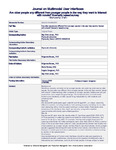Are older people any different from younger people in the way they want to interact with robots? Scenario based survey
| dc.contributor.author | Biswas, M | |
| dc.contributor.author | Romeo, M | |
| dc.contributor.author | Cangelosi, Angelo | |
| dc.contributor.author | Jones, Ray | |
| dc.date.accessioned | 2022-02-08T17:09:01Z | |
| dc.date.available | 2022-02-08T17:09:01Z | |
| dc.date.issued | 2020-03 | |
| dc.identifier.issn | 1783-7677 | |
| dc.identifier.issn | 1783-8738 | |
| dc.identifier.uri | http://hdl.handle.net/10026.1/18722 | |
| dc.description.abstract |
Numerous projects, normally run by younger people, are exploring robot use by older people. But are older any different from younger people in the way they want to interact with robots? Understanding older compared to younger people’s preferences will give researchers more insight into good design. We compared views on multi-modal human–robot interfaces, of older people living independently, with students and university staff. We showed 96 participants aged under 65 and 18 aged 65 + , six videos presenting different scenarios, including interfaces both working properly and failing, for an older man interacting with a robot by speech and touch screen tablet. Participants were asked about the interfaces they might use and why, using self-completed questionnaires with mainly open-ended questions. People over 65 were more like people under 21 than those aged 22–64 (78%, 67%, 47% respectively) in preferring speech over tablet for robot–human interaction. But reasons for doing so may differ, for example, hearing and eyesight impairment versus speaking while hands full. Older participants were more likely (83% vs. 55%) to want a robot in the house than those under 65. Older people were as familiar with tablets and smart speakers as younger people, but less likely to use smart phones. Some younger people suggested interacting with robot via their smart phone, and while not at home. Answers to similar questions about preferences for robot interaction varied according to position in the questionnaire. User-centred design of human–robot interfaces should include open questions to understand people’s preferences, should account for question wording and order in interpreting user preferences, and should include people of all age ranges to better understand interface use. Older people’s technology needs have differences and similarities to the younger people who are likely carrying out the research. Our sample of older people were more like people under 21 than those aged in between for preference of robot–human interaction, and more willing to have a robot in the home than younger people. Differences may come from a more home based lifestyle and difficulties with vision, hearing, or dexterity rather than lack of interest in technology. | |
| dc.format.extent | 61-72 | |
| dc.language | en | |
| dc.language.iso | en | |
| dc.publisher | Springer Science and Business Media LLC | |
| dc.subject | Older people | |
| dc.subject | Human-robot interaction | |
| dc.subject | Communication preferences | |
| dc.subject | User-centred design | |
| dc.title | Are older people any different from younger people in the way they want to interact with robots? Scenario based survey | |
| dc.type | journal-article | |
| dc.type | Journal Article | |
| plymouth.author-url | https://www.webofscience.com/api/gateway?GWVersion=2&SrcApp=PARTNER_APP&SrcAuth=LinksAMR&KeyUT=WOS:000512041100005&DestLinkType=FullRecord&DestApp=ALL_WOS&UsrCustomerID=11bb513d99f797142bcfeffcc58ea008 | |
| plymouth.issue | 1 | |
| plymouth.volume | 14 | |
| plymouth.publication-status | Published | |
| plymouth.journal | Journal on Multimodal User Interfaces | |
| dc.identifier.doi | 10.1007/s12193-019-00306-x | |
| plymouth.organisational-group | /Plymouth | |
| plymouth.organisational-group | /Plymouth/Faculty of Health | |
| plymouth.organisational-group | /Plymouth/Faculty of Health/School of Nursing and Midwifery | |
| plymouth.organisational-group | /Plymouth/Faculty of Science and Engineering | |
| plymouth.organisational-group | /Plymouth/REF 2021 Researchers by UoA | |
| plymouth.organisational-group | /Plymouth/REF 2021 Researchers by UoA/UoA03 Allied Health Professions, Dentistry, Nursing and Pharmacy | |
| plymouth.organisational-group | /Plymouth/Research Groups | |
| plymouth.organisational-group | /Plymouth/Research Groups/Institute of Health and Community | |
| plymouth.organisational-group | /Plymouth/Research Groups/Marine Institute | |
| plymouth.organisational-group | /Plymouth/Users by role | |
| plymouth.organisational-group | /Plymouth/Users by role/Academics | |
| dcterms.dateAccepted | 2019-07-10 | |
| dc.rights.embargodate | 2022-2-10 | |
| dc.identifier.eissn | 1783-8738 | |
| dc.rights.embargoperiod | Not known | |
| rioxxterms.versionofrecord | 10.1007/s12193-019-00306-x | |
| rioxxterms.licenseref.uri | http://www.rioxx.net/licenses/all-rights-reserved | |
| rioxxterms.licenseref.startdate | 2020-03 | |
| rioxxterms.type | Journal Article/Review |


